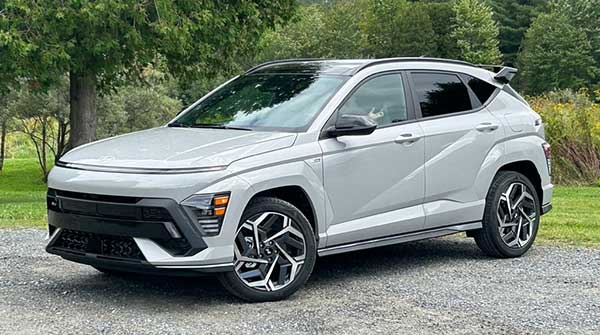Hyundai revamps Kona with increased space and advanced tech

The top-selling Kona is bigger in every way, and has been restyled.

There are big changes for Hyundai’s best-selling model, the Kona.
The Kona is a compact SUV, and competitors include the Honda HR-V, Kia Seltos, Nissan Kicks, Subaru Crosstrek and Toyota Corolla Cross. The Kona is the top-seller in this group, and last year in Canada 24,579 Konas were sold – an average of 70 every day. The Kona accounted for between 20 and 25 percent of all the Hyundai products sold in Canada during the past five years.
Despite the high sales numbers, feedback indicated that some people thought the Kona was cramped, especially regarding rear-seat legroom and cargo capacity.
“We increased every dimension of the vehicle – the length, the width, the height. We stretched the wheelbase, and we increased second-row roominess. We also increased the cargo capacity by 33 percent,” says Steve Flamand, Executive Director, Product, Corporate, IT and Digital Strategy with Hyundai Canada.
 The interior is much more spacious than the previous Kona. |
 The smooth and quiet ride is very noticeable while the Kona’s cargo volume has been increased by 33 percent. |
| Related Stories |
| Testing the futuristic all-electric IONIQ 5
|
| The Hyundai Elantra N delivers performance and luxury
|
| Low-priced Hyundai Venue includes lots of goodies
|
The new Kona is 4,350 mm (171 in) long, up 145 mm (5.7 in) from last year’s Kona. The wheelbase has been increased 60 mm (2.4 in) and is now 2,660 mm (104.7 in). It’s 1,825 mm (71.8 in) wide, an increase of 25 mm (1 in). And it’s 45 mm (1.8 in) taller, at 1,610 mm. (63.4 in)
Cargo volume now is 723 litres, an increase of 179 litres, about 33 percent. Headroom, legroom and shoulder room are all bigger. Most noticeably, the rear legroom has been increased by 77 mm (3 in).
As well as being bigger, the new Kona has been completely restyled.
There are full-width lights at the front and back and larger, triangular signal lights at both ends. Hyundai says the front styling has a “rugged and future-oriented SUV image.”
There’s also more advanced technology, like a pair of 12.3-inch screens – one is a digital cluster in front of the driver, and the other is centred above the console for infotainment. There are more seals on the doors and more insulation to make it quieter.
There are two engines for the new Kona. The base powerplant is a 2.0-litre four-cylinder engine that produces 147 horsepower. The upgraded gas engine is a 190-hp, 1.6 L turbo.
The all-electric version of the new Kona will be released in 2024 and will have a 150 kW electric motor.
Pricing starts at $25,999 for the Essential line. Next up – with added features like 18-inch wheels, heated steering wheel and adaptive cruise control – is the Preferred, at $29,499. The Preferred with the Trend Package is $32,499 and adds a power sunroof, wireless device charger and dual automatic climate control. The sporty N-Line, at $35,499, has 19-inch wheels, a 1.6 L turbo, and special badging and accents. The top model, the N-Line Ultimate, also gets the more powerful 1.6 L turbo. At $38,499, it includes remote smart parking assist, surround and blind view monitor, ventilated front seats and a Bose premium audio system.
During the media event of the new Kona at Ayer’s Cliff, Quebec, I took a new N-Line Kona for a test drive through the Eastern Townships of Quebec.
The most noticeable feature is the smooth and quiet ride. Also impressive is the spacious interior. I’ve been known to complain about tight legroom, but there’s no problem in the new Kona. I tried out both front and rear seats, and there’s ample room to stretch out. The rear bench seat isn’t quite as comfortable as the front buckets.
Styling can be subjective, but the Kona certainly has touches that are considered by many to be stylish – a bolder grill, light bars all across the front and back, and larger signal lights. Even if you don’t happen to like these touches, it’s fair to say they are the latest things – without being overdone. Some people will no doubt mistake the new Kona for larger and more expensive vehicles.
Redesigning a top-selling model requires carefully balancing the model’s strengths and identity while making changes to remain competitive.
“We are leading the segment in volume, and we don’t want to lose our place,” says Flamand.
Dale Johnson is an award-winning author, broadcaster and journalist who has worked in TV, radio, print and online. While the manufacturer provided Dale with a vehicle to test drive, the content of this review was not reviewed or accepted by the manufacturer.
For interview requests, click here.
The opinions expressed by our columnists and contributors are theirs alone and do not inherently or expressly reflect the views of our publication.
© Troy Media
Troy Media is an editorial content provider to media outlets and its own hosted community news outlets across Canada.

